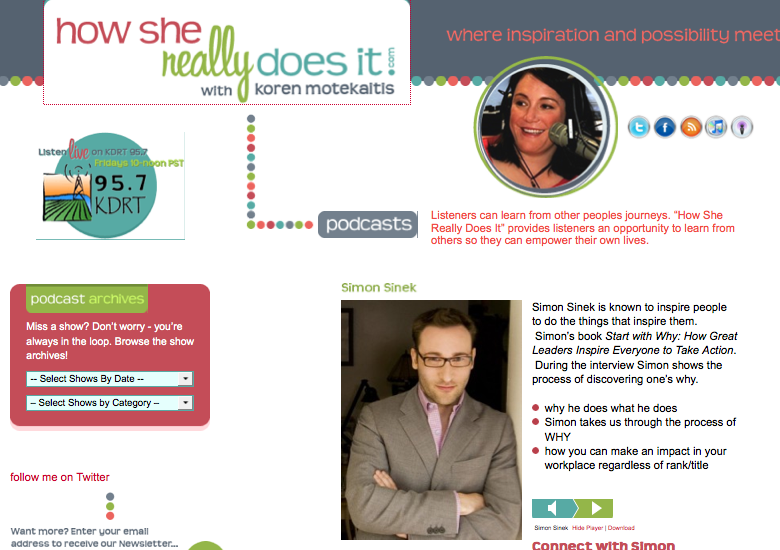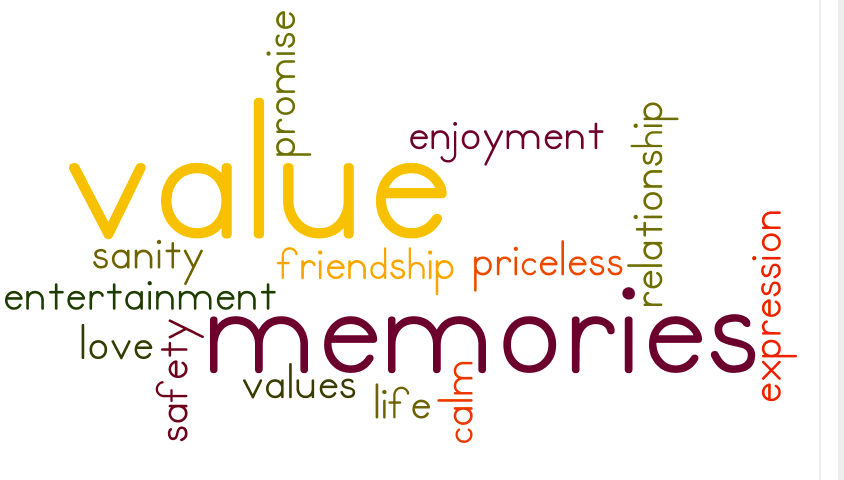Author: Leeann Hunter
Find Your Why
 Here is a small personal activity I’d like you to try on your own after having watched Simon Sinek’s TED Talk. You do not need to share your results.
Here is a small personal activity I’d like you to try on your own after having watched Simon Sinek’s TED Talk. You do not need to share your results.
1. Listen to an excerpt (minutes 16-26) from this podcast with Simon Sinek and radio host Koren Motekaitis.
2. After you have listened to the excerpt, I’d like you to replicate the activity by looking back on your life’s work thus far. What is your “resume“?
- Identify favorite activities, service projects, creative projects, courses, or similar that you have engaged in during your adult years.
- Get specific: identify a particular moment, person, or product that you recall with a deep feeling.
- Tell the story of that feeling.
3. Identify an early childhood memory that stirs up strong emotions or visuals in your mind. Again, be specific and locate the memory in space and time. Tell the story of that feeling.
4. Perhaps you need to generate more examples of your core values. If that’s the case, pull together stories that you like to share with important people in your life, or perhaps with people you have just met and are connecting to. The key (in all of these steps) is to focus on the STORY aspects of these experiences.
5. Try to find a pattern in your stories. What are the common threads?
Have you found your WHY? Remember that the key is to focus on your emotional, visceral, and intangible experiences. You may need to do more than what is listed here, but this is a start.
Checklist
8/24: BLOG: Building WordPress blogs. Identify your goals this semester.
8/27 BLOG: A. CE Prewrite. How do you identify yourself as a consumer? How might you need to change your consumer behavior, and why?
9/5 BLOG: B. CE Rhetorical Analysis. Perform a rhetorical analysis of an advertisement for a commodity you currently own. Create a new ad—with images, slogans, and text—based on your own experience of the commodity.
9/12 BLOG: C. CE Experiment. Sell or gift one commodity in your possession; purchase or receive a used commodity. Stage a series of photographs of the old and new commodities to tell their stories.
9/19 PAGE: D. CE Reflection. Revisit and revise your prewriting materials. Make a statement about consumer culture today, based on your experiences, class discussions, and class materials.
9/21 BLOG: Reflect on how you chose your materials for the consumer essay.
9/28 BLOG: What is the inspiration for your Invention Mob? What is the purpose?
10/15 BLOG: DIY Homework. In the spirit of Google’s free “20% time,” design your own homework assignment related to this course. It could be anything from reading and responding to a relevant article online to performing a social experiment of your own, or something else. Do the homework you design, summarize it in your blog post, and then analyze the value this homework has for you. Think of this assignment as preparation for coming up with a TED Talk topic. Length: minimum 300 words.
10/17 H. PAGE: Document (Individual). Perform a rhetorical analysis of your invention mob’s product. Turn this analysis into a written blog narrative accompanied by photographs, screenshots, and other process-oriented documentation. Post it as a NEW PAGE on your blog site. Include links to your group member’s blog sites and to your final product. Length: At least 1000 words and 4 original images. Draft due before class Monday, Oct 22.
10/21 BLOG: I. Brainstorm ideas for your individual TED Talk. Write a 250-word proposal.
10/26 BLOG: DIY Homework. In the spirit of Google’s free “20% time,” design your own homework assignment related to this course. It could be anything from reading and responding to a relevant article online to performing a social experiment of your own, or something else. Do the homework you design, summarize it in your blog post, and then analyze the value this homework has for you. Length: minimum 300 words.
10/29 BLOG: Complete TED Talk research preparation document: TED Talks (Blank)
10/31 BLOG: J. Research existing perspectives on your topic. Consider primary and secondary sources. Consider popular and peer-reviewed sources. Gather documents and narratives from your own experiences this semester. Create an annotated bibliography of at least 3-5 sources. Draft due by midnight. See assignment details here.
11/7 BLOG: K. Visual Essay. Produce 5-10 original slides. Use photography, charts and diagrams, or a mixture of both to create a photo essay. Revise and develop your slides until you have 10-15 visually interesting and informative ones. Draft due by midnight.
11/14 PAGE: L. Transcript. Put together a transcript of your oral presentation. Length: 6 spoken minutes (about 1000 words).
11/16 M: Produce digital TED Talk for your Blog
11/26: BLOG: In lieu of class, write a blog post (500 words or more) that reflects on your work this semester:
- Revisit the first blog post you wrote on your goals for this semester. How do you feel about those goals now?
- Re-read your favorite blog posts / pages. Why are they your favorite? What makes them different from your least favorite posts?
- Define yourself as a writer, thinker, inventor. Who have you become this semester, and how did you get there?
Annotated Bibliography
We will discuss the details of the annotated bibliography in class on Wednesday, October 31. I have outlined the details of the assignment, as well as examples, on this page.
Creating Your Research Agenda
Blog Feed Survey
Professional Interventions: A Playlist
Technologies of the Individual
Classes began today. I’m teaching an introductory survey of English literature on the “Technologies of the Individual.” Here is the course description.
“Never judge a book by its cover.” A simple truth, and yet, our culture is driven by its obsession with creating “image.” Magazines and television shows teach us hair, styling, and exercise techniques directed at further shaping this image of ourselves, an image that will presumably reveal the “real you,” but nevertheless a reality that remains on the surface of the body, on the “cover.”
Similarly, when we think about identity and the individual, we might create a mental picture based on one’s personal style, professional identity, leisure activities, or, at a more sophisticated level, cultural markers of distinction (race, class, gender, sexuality).
But even as we attempt to invoke representations of a deeper nature, our perceptions of the individual remain largely externalized. We rarely invest ourselves in the machinery of the inner life of the individual.
What kind of portrait might we paint that imagines the breathless fears, pulsating desires, and remorseful thoughts that mark the inner spirit of the individual? One of our most coveted desires as human beings is to witness the soul of another human being; one of our greatest fears is that someone other will catch a glimpse of our own.
One of the appeals, then, of reading literature is that it provides access to the hidden and complex inner life of the individual. In this survey course, we will examine texts that enjoin the spiritual and mechanical spirit of the age with a dynamic exploration of selfhood. As critics, and as individuals, we will piece together a portrait of the inner lives we witness and also experience.
The reading list includes:
- Thomas Carlyle. “Signs of the Times” and Sartor Resartus.
- Mary Shelley. Frankenstein.
- George Eliot. The Lifted Veil.
- Robert Louis Stevenson. The Strange Case of Dr. Jekyll and Mr. Hyde.
- Oscar Wilde. The Picture of Dorian Gray.
- Aldous Huxley. Brave New World.
